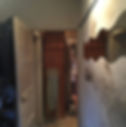Prince Krofa’s Guide to Condensation and How to Prevent It
- Joe Bleasdale
- Sep 9, 2021
- 4 min read
Condensation, mould, damp…whatever you call it, it is smelly, unattractive, and can cause huge damage to both homeowners and structures that carries high repair costs if left to thrive. However, if you know how to spot it, and who to contact, it is much simpler to deal with. Prince Krofa & Sons can advise you on condensation through surveys.

What is condensation?
Although most visible during cold winter months, condensation and damp is not seasonal. It is caused by a combination of high humidity and poor ventilation within a property.
Warm temperatures causes moisture vapour to rise, and it is converted back into a liquid as water droplets when it comes into contact with cold surfaces, usually walls and ceilings, and especially on non-porous materials such as windows, tiles and painted walls. The temperature of this state change is known as the “dewpoint” temperature.
However, this does not mean damp cannot grow on fabrics, such as carpets and clothes, and it is often only until the discovery of mould that a homeowner, occupant or landlord is made aware of the problem.
When does it become a problem?
Even small amounts of damp can develop into black mould and mildew, particularly in poorly-ventilated bathrooms and lofts, where water is commonplace, and spots can develop before spreading over much larger areas if untreated. This can severely weaken a structure, particularly wooden ones, which are especially sensitive to moisture accumulation, and causes damage to assets, fabrics and the health of occupants.
Damp is not only unsightly and smelly, but can, in some circumstances, contribute to poor health conditions, such as nasal congestion, asthma and throat irritation. Mould produces allergens (substances that can cause an allergic reaction), irritants and, sometimes, toxic substances. Inhaling or touching mould spores may cause an allergic reaction, sneezing, a runny nose, red eyes and skin rash. Moulds can also cause asthma attacks.

What factors can drive condensation and mould growth?
Virtually all air in occupied buildings will contain moisture, especially in homes, due to bathing, cooking
and washing / drying clothes. Older buildings, and those with poor grouting, are especially susceptible. Lifestyle factors that drive mould growth include, but are not limited to:
- Installing double-glazed windows without also installing supplementary ventilation
- Installing showers, Jacuzzis and saunas without or with poor extractor fans
- Using tumble driers without or with poor outside ventilation
- Blocking / refurbishing walls with existing vents
- Sealing roof voids
- Blocking windows or vents to basement areas
- Drying clothes on radiators
- Using paraffin and / or flue-less gas heaters.
How have modern-day building practices made condensation more common?
In our environmentally-conscious age, many homeowners have opted for more robust insulation options in their homes, in the hope of saving money and energy on their heating bills. Unfortunately, a knock-on effect, particularly of loft insulation, is that, if proper ventilation is not invested in, there is significantly reduced air movement opportunity, which results in humid surfaces apt for condensation, damp and mould development.
Although we recommend practices like this, it is more important to be aware of damp if this applies to you.
How do I prevent condensation from getting worse?
Many occupants, especially students or people renting / owning homes for the first time, may turn to a dehumidifier as a cheap, one-click solution to condensation. While this is okay at reducing damp in warm, humid, often non-domestic environments, it is fairly ineffective if the surfaces are already cold, and as soon as it is switched off.
For home environments, it would be cost-effective in the long-term to invest in adequate, well-insulated heating and ample ventilation (the latter becoming a priority for construction in the pandemic we are currently living through), as well as implementing lifestyle changes to reduce the amount of moisture accumulating in your home, roughly based on the list above. This will ensure the surfaces are constantly kept above “dew point” temperature, and are less susceptible to vapour condensing.
How can Prince Krofa & Sons help you in condensation matters?
If you are concerned about damp, condensation or mould, and you are a homeowner, building owner, occupant or landlord in London and the Home Counties, our surveyors advise you on how damp might affect your building and give you locally-sourced advice on how to go about dealing with it in an effective manner.

A common piece of kit used on a survey is a moisture meter, which is used to measure the percentage of water in a given substance, usually a wall, ceiling or timber. This information can be used to determine if the structure is unexpectedly wet or dry, or otherwise in need of further inspection.
Prince Krofa & Sons have encountered some heavily damp surfaces on surveys, many of which were in bedrooms, bathrooms and kitchens of buildings occupied at the time. It can be astonishing to think that people were living with these immediate health hazards, but many may simply not know enough about just how damaging condensation can become, or didn’t think they could afford to repair it.
Our contacts page, where you can also book a survey, is here.
You can also find us on Facebook, Instagram and LinkedIn, as well as sign up for our newsletter, for further advice, business news and updates.

Sources:
http://ukdampsurveys.com/condensation/
https://uk.rs-online.com/web/c/test-measurement/environmental-test-measurement/moisture-meters/
https://britishinsulation.co.uk/bounce-back-programme/?utm_source=bing&utm_medium=cpc&utm_term=home%20insulation%20foam&msclkid=7d1564ae557d102ce82a05946bba5842
https://www.nhs.uk/common-health-questions/lifestyle/can-damp-and-mould-affect-my-health/
https://www.hydehousing.co.uk/damp/#:~:text=The%20number%20one%20cause%20of%20damp%20and%20subsequent,of%20it%20to%20prevent%20it%20getting%20more%20serious.
https://www.axa.co.uk/home-insurance/tips-and-guides/how-to-get-rid-of-mould-for-good/
https://www.nhbc.co.uk/binaries/content/assets/nhbc/homeowners/moving-in/running-in-your-new-home.pdf




